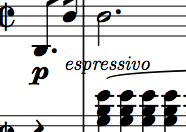Frédéric Chopin (1810-1849)
Composed mainly solo piano works, amongst them études, nocturnes, and préludes.
Prelude, Op. 28, No. 4 (1838)
Hans von Bülow called the prelude “suffocation”, due to its sense of despair.
Two different versions:
[audio:http://www.jaimeoliver.pe/snd/mh/chop/prel-1.mp3] [audio:http://www.jaimeoliver.pe/snd/mh/chop/prel-2.mp3]First of all let’s take a look at the first few bars of the score:
Let’s point at a couple facts:
 The rhythm in the left hand is notated in consecutive 8th notes and there is no indication of tempo changes so it should be played evenly.
The rhythm in the left hand is notated in consecutive 8th notes and there is no indication of tempo changes so it should be played evenly.- The melody is usually confined to a range of a semitone or a tone at a time.
- The chord succession in the left hand descends chromatically. For every triad change: a note or two are always carried on to the next chord as suspensions and a note or two descend by a half step, that is, down through the chromatic scale.
Let’s watch the following video. Try to compare the human performance to the machine rendition and observe the way the chords and melody descend:
rhythmic expressivity and interpretative freedom
 Going back to the subject of rhythmic performance, while the machine provides an inexpressive rendition, the differences between notation and performance are explained by the term espressivo at the beginning of the score:
Going back to the subject of rhythmic performance, while the machine provides an inexpressive rendition, the differences between notation and performance are explained by the term espressivo at the beginning of the score:
In the context of Chopin’s work, tempo is performed with expressive freedom called tempo rubato. In this case, the performer has a bigger role in determining the final shape that the piece will have, beyond the control of the composer.
Ideas for thought
As we saw earlier, dissonance creates tension that demands relaxation/ consonance and if cadences provide release by resolving tension. Music metaphorically breathes with cadences.
Using a different metaphor, constraining melodic and harmonic movements to small steps and ranges makes a small space in which to breathe.
Q1.1 Are the terms suffocation and despair consistent with the use of the musical material?
Q1.2 How does Chopin’s use of chromatic descent compare to Schubert’s use of ascending chromatic modulation?
Q1.3 What function do the following excerpts have?
[audio:http://www.jaimeoliver.pe/snd/mh/chop/section-2.mp3] [audio:http://www.jaimeoliver.pe/snd/mh/chop/final-cadence.mp3]